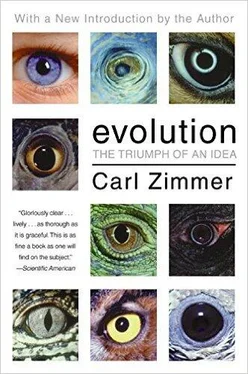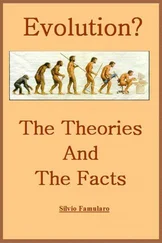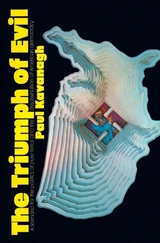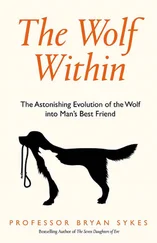Whiten A. “Social complexity and social intelligence.” In J Goode J, ed., The nature of intelligence. New York: Wiley, 2000, pp. 185–201.
—, Byrne RW. Machiavellian intelligence II: Extensions and
evaluations. London & New York: Cambridge University Press, 1997.
— , Goodall J, McGrew WC, Nishida T, Reynolds V, Sugiyama Y, et al. “Cultures in chimpanzees.” Nature, 1999, 399: 682–685.
Wilson EO. Sociobiology: The new synthesis. Cambridge, Mass.: Belknap Press, 1975.
Wright R. The moral animal: Evolutionary psychology and everyday life. New York: Pantheon Books, 1994.
CHAPTER 12: MODERN LIFE, 50,000 B.C.: THE DAWN OF US
Bertranpetit J. “Genome, diversity, and origins: The Y chromosome as a storyteller.” Proceedings of the National Academy of Sciences, 2000, 97: 6927–6929.
Blackmore SJ. The meme machine. Oxford & New York: Oxford University Press, 1999.
Cavalli-Sforza LL. Genes, peoples, and languages. New York: North Point Press, 2000.
Chauvet J-M, Brunei Deschamps E, Hillaire C. Dawn of art: The Chauvet Cave, the oldest known paintings in the world. New York: Abrams, 1996.
Dyson G. Darwin among the machines: The evolution of global
intelligence. Reading, Mass.: Addison-Wesley, 1997. Ehrlich P. Human natures. Washington, D.C.: Island Press, 2000. Holden C, Mace R. “Phylogenetic analysis of the evolution of lactose
digestion in adults.” Human Biology, 1997, 69: 605–628. Klein RG. The human career: Human biological and cultural origins.
Chicago: University of Chicago Press, 1999. Krings M, Capellia C, Tschendtscher F, Geisert H, Meyer S, von Haeseler A, et al. “A view of Neandertal genetic diversity.” Nature Genetics, 2000, 26: 144–146.
— , Geisert H, Schmitz RW, Krainitzki H, Pääbo S. “DNA sequence of the mitochondrial hypervariable region II from the neandertal type specimen.” Proceedings of the National Academy of Sciences, 1999, 96: 5581–5585.
—, Stone A, Schmitz RW, Krainitzki H, Stoneking M, Pääbo S.
“Neandertal DNA sequences and the origin of modern humans.” Cell, 1997, 90: 19–30. Lewontin RC. Human diversity. New York: Freeman, 1995. Mithen SJ. The prehistory of the mind: A search for the origins of art, religion and science. London: Thames 8c Hudson, 1996. Nemecek S. “Who were the first Americans?” Scientific American, 2000, 283: 80–87.
Ovchinnikov IV, Gotherstrom A, Romanova GP, Kharitonov VM, Liden K, Goodwin W. “Molecular analysis of Neanderthal DNA from the northern Caucasus.” Nature, 2000, 404: 490–493. Pääbo S. “Human evolution.” Trends in Cell Biology, 1999, 9: 13–16. —. “Neolithic genetic engineering.” Nature, 1999, 398: 194–195.
Richards MP, Pettitt PB, Trinkaus E, Smith FH, Paunovic M, Karavanic I. “Neanderthal diet at Vindija and Neanderthal predation: The evidence from stable isotopes.” Proceedings of the National Academy of Sciences, 2000, 97: 7663–7666.
Shen P, Wang F, Underhill PA, Franco C, Yang WH, Roxas A, et al. “Population genetic implications from sequence variation in four Y chromosome genes.” Proceedings of the National Academy of Sciences, 2000, 97: 7354–7359.
Shreeve J. The Neandertal enigma: Solving the mystery of modern human origins. New York: Morrow, 1995.
Tattersall I. Becoming human: Evolution and human uniqueness. New York: Harcourt Brace, 1998.
Zimmer C. “After you, Eve.” Natural History, March 2001, 32–35.
CHAPTER 13: WHAT ABOUT GOD?
Behe MJ. Darwin’s black box: The biochemical challenge to evolution. New York: Free Press, 1996.
Cartmill, M. “Oppressed by evolution.” Discover, March 1998, 78–83.
Chen L, DeVries AL, Cheng CH. “Evolution of antifreeze glycoprotein gene from a trypsinogen gene in Antarctic notothenioid fish.” Proceedings of the National Academy of Sciences, 1997, 94: 3811–3816.
Cheng CH, Chen L. “Evolution of an antifreeze glycoprotein.” Nature, 1999,401,443–444.
Darwin C. Autobiography and selected letters. New York: Dover Publications, 1958.
Dawkins R. Unweaving the rainbow: Science, delusion, and the appetite for wonder. Boston: Houghton Mifflin, 1998.
Dupree, A. H. Asa Gray, 1810 – 1888. Cambridge, Mass.: Harvard University Press, 1959.
Gasman, D. The scientific origins of National Socialism: social Darwinism in Ernst Haeckel and the German Monist League. New York: Elsevier, 1971.
Gould SJ. Rocks of ages: Science and religion in the fullness of life. New York: Ballantine, 1999.
—. “Non-overlapping Magisteria.” Skeptical Inquirer, 1999, 23: 55–61.
Haeckel EHPA, Lankester ER. The history of creation: or, The development of the earth and its inhabitants by the action of natural causes. London: Henry S. King, 1876.
Larson EJ. Summer for the gods: The Scopes trial and America’s continuing debate over science and religion. Cambridge, Mass.: Harvard University Press, 1998.
Miller KB. “Theological implications of an evolving creation.” Perspectives on Science and Christian Faith, 1993, 45: 150–160.
Miller KR. Finding Darwin’s god: A scientist’s search for common ground between God and evolution. New York: Cliff Street Books, 1999.
Moore JR. “Of love and death: Why Darwin ‘gave up Christianity.’ ” In JR Moore, ed., History, humanity, and evolution: Essays for John C. Greene. Cambridge, Mass.: Cambridge University Press, 1989, pp. 195–229.
National Academy of Sciences. Science and creationism: A view from the National Academy of Sciences. Washington, D.C.: National Academy Press, 1999.
Numbers RL. The creationists. New York: Knopf, 1992.
Orr HA. “Darwin v. intelligent design (again).” Boston Review, December 1996, 28–31.
Peel JDY. Herbert Spencer: The evolution of a sociologist. New York: Basic Books, 1971.
Pennock RT. Tower of Babel: The evidence against the new creationism. Cambridge, Mass.: MIT Press, 1999.
Wilson EO. “The biological basis of morality.” Atlantic Monthly, 1998, 281: 53–70.
—. Hardwired for God. Forbes ASAP. Supplement, 1999: 132–134.
—. Naturalist. Washington, D.C.: Island Press, 1994.
—. “The two hypotheses of human meaning.” The Humanist, 1999,
This book is part of the Evolution Project, a co-production of the WGBH/NOVA Science Unit and Clear Blue Sky Productions. The project also includes a seven-part television series, a Web site, a multimedia library, and an educational outreach program. It has been an honor and a pleasure to be involved with so many talented people on such a large enterprise. Special thanks to Paul G. Allen and Jody Patton at Clear Blue Sky Productions for their inspiring vision for and generous support of the Evolution Project, and to Paula Apsell of the WGBH/NOVA Science Unit for guiding its development. I am grateful to them for bringing me aboard.
Richard Hutton, the executive producer of the television series, reined in the unruly science of evolutionary biology to create seven compelling episodes, consulted with dozens of leading scientists, oversaw a production staff traveling around the world, and yet always had time to chat with me about the fine points of the Cretaceous-Tertiary mass extinctions or Charles Darwin’s family life. I thank him for his leadership and intellectual companionship. To shape the editorial structure of the series, Richard worked with NOVA senior editor Steve Lyons, series science editor Joe Levine, and associate producer Tina Nguyen. I particularly want to thank Joe for many insightful e-mail exchanges, and Tina for helping me track down various chunks of information, no matter how esoteric.
Читать дальше












